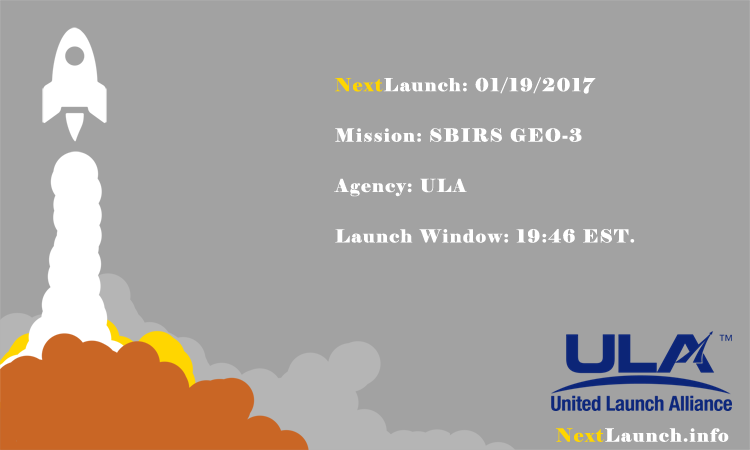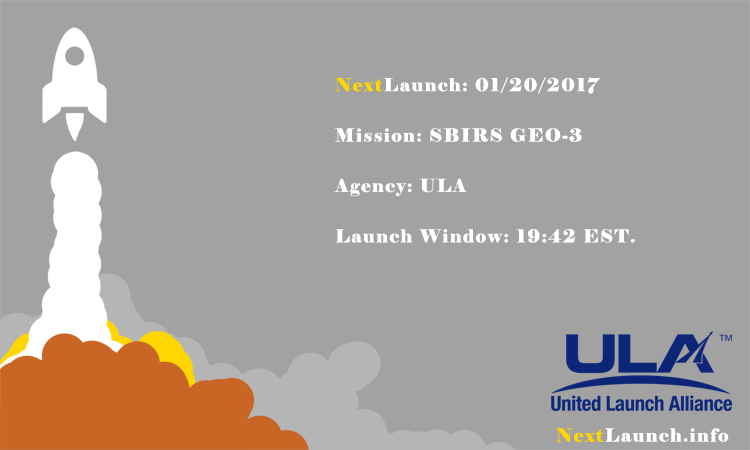
Current Schedule Launch Time: 19:46 EST 01/19/2017
Launching Agency: United Launch Alliance
Payload: SBIRS GEO-3
Launch Vehicle: Atlas V
Live Countdown
Stream
Mission Homepage
SBIRS uses infrared surveillance to provide early missile warning for the U.S. military and is considered one of the nation’s highest priority space programs. The system includes a combination of satellites and hosted payloads in Geosynchronous Earth Orbit (GEO) and Highly Elliptical Orbit (HEO) and ground hardware and software.
SBIRS has powerful overhead sensors that provide vast amounts of data. At the SBIRS Mission Control Station, Overhead Persistent Infrared Battlespace Awareness Center at Buckley Air Force Base, Colorado, this data is being used for operational applications across areas like battlespace awareness, intelligence and 24/7 tactical alerts.
As the demand for remote sensing capabilities continues to rise, the U.S. Air Force’s newly created data utilization Lab is bringing together government, industry and academia to better understand how data from satellites like SBIRS can be better applied on and off the battlefield.
Source.
SBIRS has powerful overhead sensors that provide vast amounts of data. At the SBIRS Mission Control Station, Overhead Persistent Infrared Battlespace Awareness Center at Buckley Air Force Base, Colorado, this data is being used for operational applications across areas like battlespace awareness, intelligence and 24/7 tactical alerts.
As the demand for remote sensing capabilities continues to rise, the U.S. Air Force’s newly created data utilization Lab is bringing together government, industry and academia to better understand how data from satellites like SBIRS can be better applied on and off the battlefield.
Source.
United Launch Alliance (ULA) is a joint venture of Lockheed Martin Space Systems and Boeing Defense, Space & Security. ULA was formed in December 2006 by combining the teams at these companies which provide spacecraft launch services to the government of the United States. U.S. government launch customers include both the Department of Defense and NASA, as well as other organizations. With ULA, Lockheed and Boeing held a monopoly on military launches for more than a decade, until the US Air Force awarded a GPS satellite contract to SpaceX in 2016.
ULA provides launch services using three expendable launch systems – Delta II, Delta IV and Atlas V. The Atlas and Delta launch system families have been used for more than 50 years to carry a variety of payloads including weather, telecommunications and national security satellites, as well as deep space and interplanetary exploration missions in support of scientific research. ULA also provides launch services for non-government satellites: Lockheed Martin retains the rights to market Atlas commercially.
Beginning in October 2014, ULA announced that they intended to undertake a substantial restructuring of the company, its products and processes, in the coming years in order to decrease launch costs. ULA is planning on building a new rocket that will be a successor to the Atlas V, using a new rocket engine on the first stage. In April 2015, they unveiled the new vehicle as the Vulcan, with the first flight of a new first stage no earlier than 2019.
Source.
ULA provides launch services using three expendable launch systems – Delta II, Delta IV and Atlas V. The Atlas and Delta launch system families have been used for more than 50 years to carry a variety of payloads including weather, telecommunications and national security satellites, as well as deep space and interplanetary exploration missions in support of scientific research. ULA also provides launch services for non-government satellites: Lockheed Martin retains the rights to market Atlas commercially.
Beginning in October 2014, ULA announced that they intended to undertake a substantial restructuring of the company, its products and processes, in the coming years in order to decrease launch costs. ULA is planning on building a new rocket that will be a successor to the Atlas V, using a new rocket engine on the first stage. In April 2015, they unveiled the new vehicle as the Vulcan, with the first flight of a new first stage no earlier than 2019.
Source.
GO ATLAS, GO CENTAUR, GO ULA!

